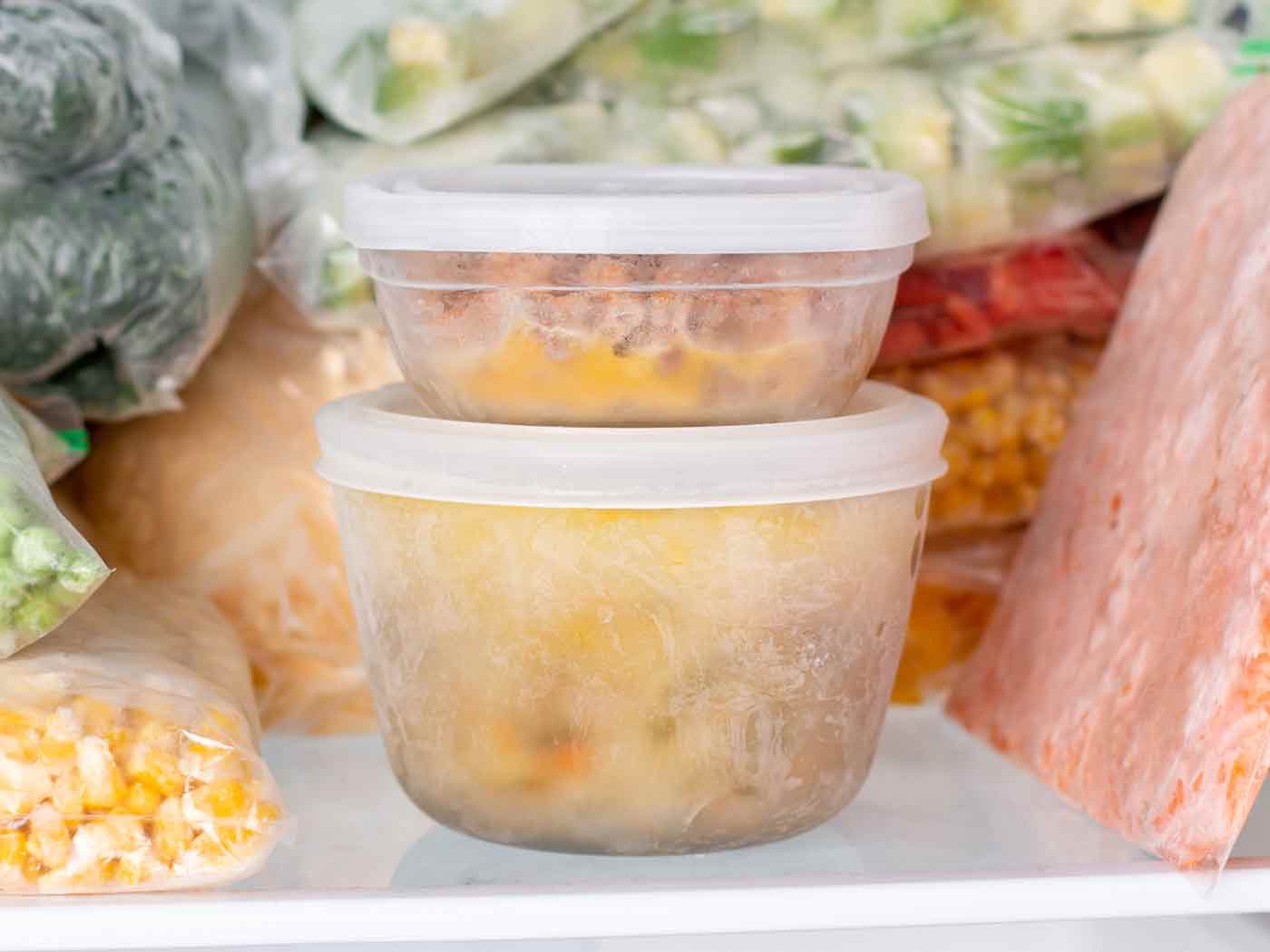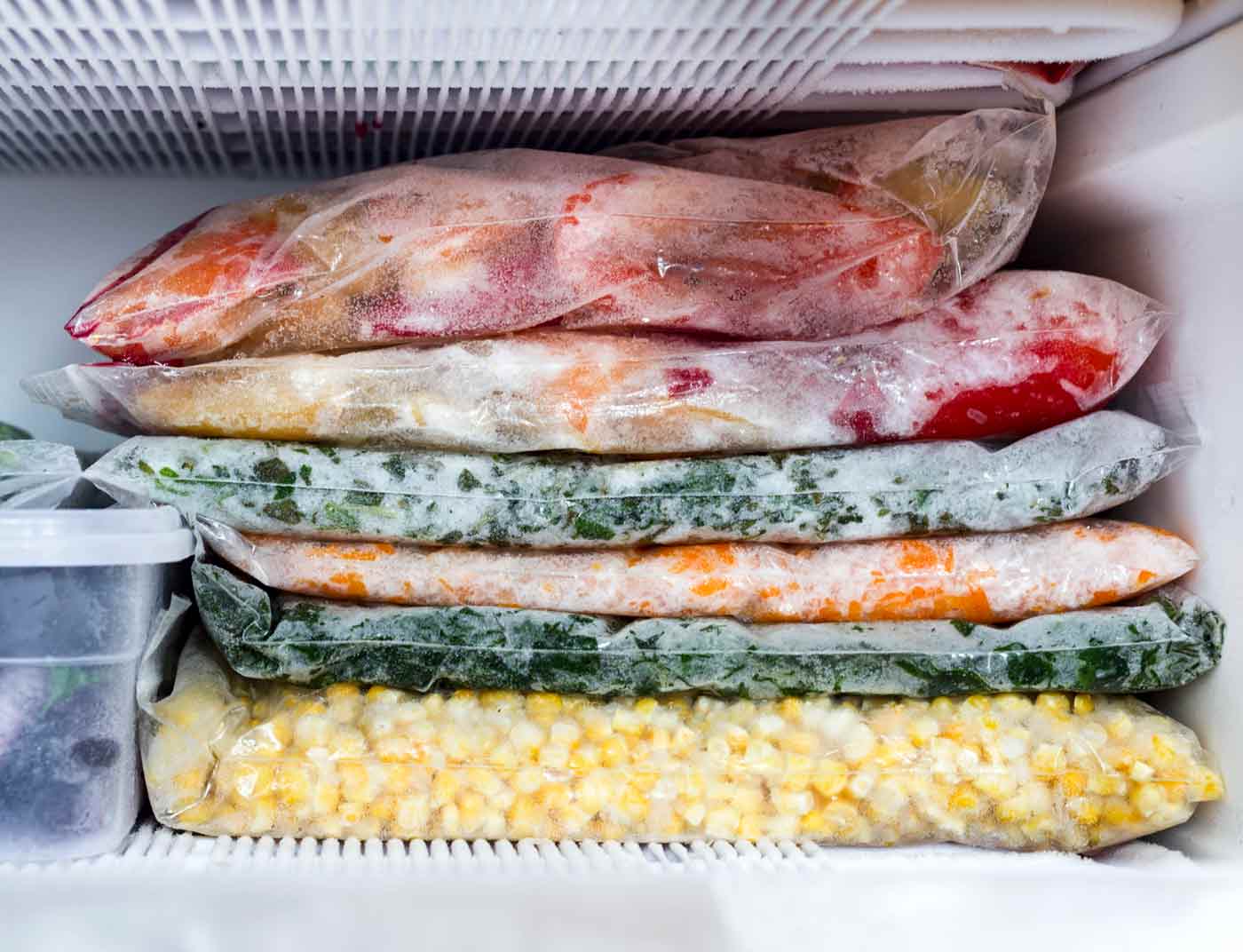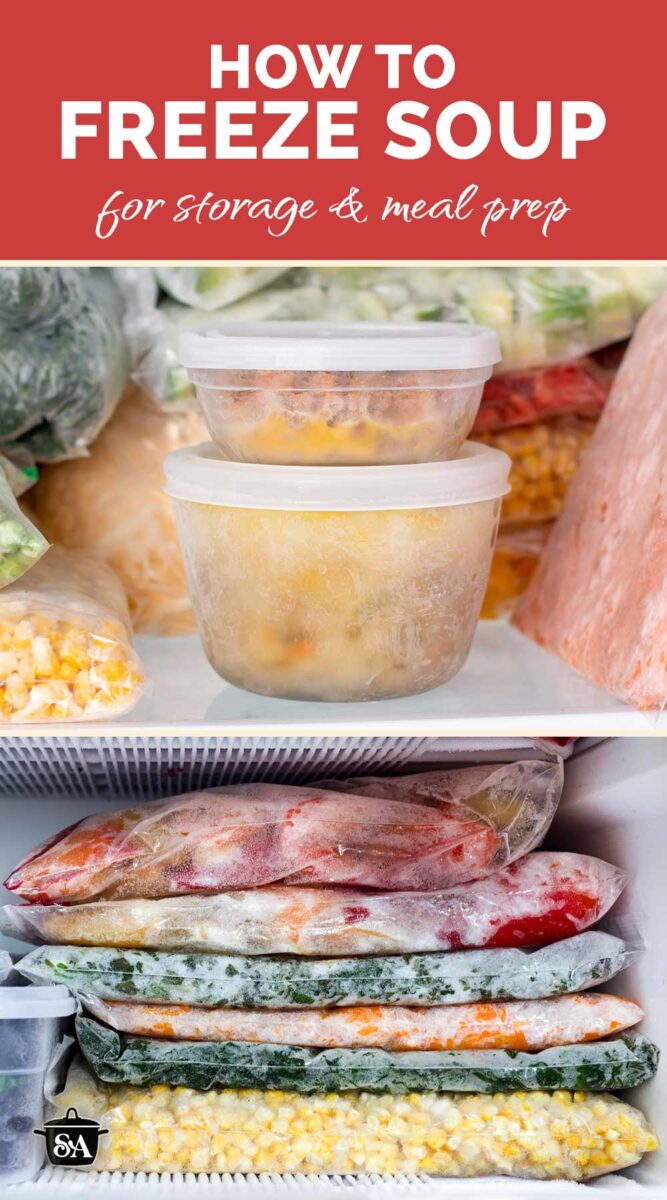Freezing soup is a smart way to prep for future meals, preserve leftovers, and save money. I have lots of tips from years of freezing different kinds of soups, and you’ll find my best advice here for what types of soups freeze well to container suggestions to thawing and reheating. Make lots of soup … and freeze it up!

What kinds of soups can be frozen?
It’s easier to answer the question, what kinds of soups shouldn’t be frozen? Some common (and favorite) soup ingredients don’t freeze well — or don’t freeze well immersed in liquids — and will change the texture of soup once thawed and reheated.
It’s best to avoid soups that contain dairy, including milk, cream, cream cheese, a roux or bechamel, and cheese sauces. Dairy products tend to “break” after thawing, with the liquids separating from the solids. Unless it’s a pureed soup that can reblended as a whole — and it really does work to recombine everything via blending — there’s not much you can do to repair a chunky soup whose dairy component has separated.
This caution includes plant-based milks, such as coconut and almond, as they also separate when frozen and thawed.
Pasta, potatoes, white rice, and other grains/seeds, including quinoa are differently problematic in frozen soups. They’ll continue absorbing water until the moment they’re frozen, and then once thawed and reheated, will reconstitute into a mushy shadow of their former selves. And the soup will be decidedly more stewy than soupy.
Seafood soups are also tricky. Their texture can change during the thaw/reheat process, and the result is often too weird and rubbery to eat.
Soups that freeze well in general are bean soups, vegetable soups, meat-based soups, and broths. Wild rice and brown rice are sturdier and usually hold up to freezing pretty well.
Browse my collection of over 30 Freezer Soups and get some inspiration!
What can you do about soup recipes with dairy and pasta?
The good news there is that if you’re making an entire patch of soup to freeze, you can simply leave out the uncooperative ingredient until you reheat the soup. Both dairy and pasta are often added at the end of a soup’s cook, so it’s just as easy to add at the end of reheating a frozen soup.
So, for example, if you’re making my Cold-fighting Couscous Chicken Soup to freeze ahead of cold and flu season (always a good idea!), just skip the pearl couscous and continue with the recipe. When you reheat the soup, cook up a quick batch of pearl couscous in a separate pot and add it to the soup just before serving.
If you’re making my Southwest Corn Chowder to freeze ahead for an easy future dinner, leave out the half-and-half, the sour cream, and the cheese until you’re reheating the soup. It might seem like it’s not worth the effort, but it’s good to remember that most of the work in making soup is the ingredient prep — slicing vegetables and meat cuts and whatnot — and the initial cook, so simply stirring in a few ingredients later takes no time at all.
This approach also applies to seafood and shellfish soups: It’s best to leave out ingredients like fish, shrimp, and scallops, and instead freeze the soup base and cook up and add the seafood fresh when you reheat the soup.
I’ll also mention that some soups might not be worth the trouble, depending on how you feel about the mush factor. Potato soup, for example, consists of, well, potatoes, which can’t really be left out of potato soup. They’re starchy vegetables that love to fall apart after freezing.
But honestly, that mush factor might not even be an issue for you, if it’s something like leftovers for a future lunch. If you’re gung-ho about freezing soups, it’ll just take a little experimentation on your part to see what your tolerance level is for reheated soups.
Containers for Freezing Soup
Note that I’m linking to Amazon (with affiliate links) so you can view and read more about the products, but some could be available at your favorite local retailer.
Souper Cubes: 2-cup Silicone Freezer Tray
This was such a clever idea, to use what is basically the ice cube tray model to freeze soup. Once frozen, they can be popped out directly into a pot, or divvied up amongst multiple containers for each family member to take for lunch.
Souper Cubes: 1-cup Silicone Freezer Tray
A smaller version of the trays above.
Freezer-safe Food Containers: 32 ounces (24 count)
I love these things. They have so many uses, in and out of the freezer, and they’re cheap enough that it’s no big deal if one gets ruined. They’re designed for freezing, and the lids seal tight, so no worries about leakage.
Freezer-safe Food Containers: 16 ounces (24 count)
These are the smaller versions of the containers above, perfect for individual servings of just under 2 cups of soup (always leave that headroom!).
Gladware Freezerware Food Storage Containers: 64 ounces
This massive size is handy for freezing whole pots of soup in one batch. I use various sizes of this brand all the time, and they’ve held up well, from freezer to dishwasher and back again.
Blank, Removable White Freezer Labels: 1 role of 1000
I’ve learned not to trust my memory anymore and just immediately label everything that goes into the freezer. Secure but removable labels are the way to go. I also recommend using a permanent marker rather than a ballpoint pen, which tends to smear.
In addition to containers, I sometimes store soup in ziploc freezer bags, freezing them flat, and then standing them up in the freezer, wedged against the wall, or stacked on top of other bagged frozen foods. I’ll add that I prefer the press zippered bags (with the tracks that you press or pinch together) to the sliding zippered bags, because sometimes those sliding zippers don’t seem to seal all the way shut.
Can you freeze soup in mason jars?
Technically speaking, yes. Be sure to use freezer-safe jars, and choose only straight-sided jars, not the kinds with curved shoulders at the top. Cool your food completely before placing it in the freezer, and leave plenty of headroom in the jar — at least one inch between the surface of the food and the lid. Don’t tighten the lid completely — wait until everything is frozen.
Personally, I never use glass for freezing anything. While I acknowledge the reusability benefits of glass, I can’t comfortably recommend using glass. Even freezer safe jars become fragile at such low temps, and the process of freezing a warm jar with warm contents, and then warming a frozen jar with frozen contents, can cause it to weaken and unexpectedly crack. Some folks successfully use glass jars to freeze food all the time; it’s just not for me.

How to Prepare Soup for Freezing
Now for the deets. You can freeze soup in three simple steps:
1. Let the soup cool
This is a critical step to maintain food safety for both the soup and the other items in your freezer. Make sure you remove the soup pot from the hot burner.
If you’re using a cooking vessel, like cast iron (or enameled cast iron), that efficiently and stubbornly hangs onto heat within its walls, pour the soup into another large pot to speed up the cooling.
2. Transfer the soup to freezer containers
Once the soup has cooled, pour the soup into your chosen container(s), leaving plenty of room — at least one inch — between the soup and the lid (or the soup and freezer bag zipper) for the expansion that will occur as the soup freezes.
You can combine steps 1 and 2 if you’re using heat-safe freezer containers: If the soup is still quite hot, you can go ahead and divide the soup into those containers, leaving them uncovered on the counter until the soup reaches room temperature.
3. Place the container in the freezer
Position the container in a stable, upright spot in the freezer, where there’s no risk of falling askew (you don’t want the soup half frozen to the lid).
If you’re using ziploc bags, freeze them flat, either on a shelf in the freezer, or place them on a small baking sheet and position the baking sheet level in the freezer. Once the soup has frozen in the bag, you can remove the baking sheet, and position the bag as it best fits, either lying flat or standing up like a book.
How to Reheat Frozen Soup
Most soups benefit from a slow thaw, rather than being blasted by heat by dumping the frozen mass directly into a pot set on high or in the microwave. This preserves the textures of the ingredients within and prevents vegetables and tenderized meats from getting mushy.
Place the container in the fridge overnight, which will thaw it most of the way, if not all of the way, depending on the size of the container (the larger the container, the longer it will take).
One particular advantage of the refrigerator is that if it does happen to thaw quickly, food safety is protected by the temperature in the fridge, as opposed to the soup sitting out on the counter for hours.
Once thawed, you can reheat on the stove or in the microwave. In both cases, you want to go with a gentle heat, not a full boil.
Stovetop: Use a medium heat setting on the stovetop, stirring often once the soup begins to loosen up.
Microwave: Use longer and medium-powered heat settings in the microwave — say, 50% power for 8 minutes — stirring halfway through. Test for temperature at the end, and continue heating in one-minute intervals until hot.
While your soup reheats, prepare the “add later” ingredients, such as cooking up pasta, rice, or potatoes, and measuring out dairy products.
I’d like to wrap things up with one comment and a suggestion: The tips above are best practices for preserving the integrity of your soups during freezing. That’s not to say that you can’t bend the rules.
Ingredients that don’t freeze well, such as dairy and pasta, don’t go bad in the freezer. They simply get weird, texture-wise. I’ve frozen plenty of soups that really shouldn’t be frozen, and have been completely happy with the different but still tasty result. Pasta gets mushy, but for my tastes, it’s just fine: Instead of a perfectly formed rotini noodle, it could break down into soft, smaller blobs. I might not serve it to guests, but I’m okay with it for me.
If you want reliable results, stick to the rules. If you’re open to a little experimentation and can live with the risk of imperfect batch of soup, give freezing a try.
But whatever you decide, it’s soup season — let’s get cooking!


